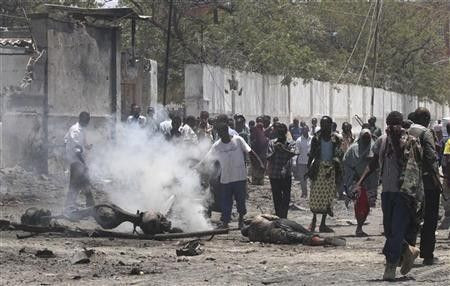Rebels kill scores in Somali capital blast

Tue Oct 4, 2011 5:32pm GMT
By Abdi Sheikh and Mohamed Ahmed
(Reuters) - Somalia's al Qaeda-linked rebels struck at the heart of the capital on Tuesday, killing scores of people with a truck bomb in the group's most deadly attack in the country since launching an insurgency in 2007.
Mogadishu's ambulance coordinator Ali Muse said at least 70 people had been killed by the blast. The African Union force in Somalia (AMISOM) said the attack had claimed scores of lives.
The AU force said a truck laden with drums of fuel rammed a checkpoint outside a compound housing government ministries in the K4 (Kilometre 4) area of Mogadishu, where students had gathered to register for scholarships offered by Turkey.
The al Shabaab insurgents who carried out the attack later warned Somalis to stay away from government buildings and military bases. More serious blasts are coming, spokesman Sheikh Ali Mohamud Rage told reporters.
The twisted axle from the exploded truck lay on blackened soil. A body draped with a red shawl lay nearby. People used corrugated iron, rugs and white sheeting to carry corpses away from the devastation at a normally bustling junction.
Ambulances rushed to and fro past twisted, charred trees and a burnt out car. Hundreds of parents stood weeping outside the Madina Hospital in Mogadishu after being denied access for security reasons and nurses said they were overwhelmed.
I was among the first people to arrive here moments after the explosion. I looked around and reassured those who were still alive, said witness Halma Abdi.
Britain slammed the blast as callous while France said it was a vile terrorist attack and reasserted its support for the country's U.N.-backed transitional government.
The U.N. special envoy to Somalia, Augustine Mahiga, said he was deeply saddened by the senseless, cowardly attack.
It is very difficult to prevent these types of terrorist attacks which we have consistently warned are likely to be on the increase, he said.
The government said no senior officials were hurt in the attack on the ministry buildings.
BURNS AND FRACTURES
Al Shabaab insurgents pulled most of their fighters out of Mogadishu in August allowing government troops and African Union soldiers to seize much of the capital. But the rebels vowed to still carry out attacks on government installations.
AMISOM still considers al Shabaab as a terrible group and will work with other partners to stop their horrible attacks on civilians, the AU force spokesman Paddy Ankunda said.
The blast flattened kiosks near the compound and a charred body lay near a blazing car. Debris from the explosion landed hundreds of metres away.
Scores of people with burns walked to a nearby hospital and police were trying to evacuate more students trapped inside the damaged buildings. Doctors said they were shocked by the number of casualties, in a city that has endured years of violence.
The International Committee of the Red Cross said more than 90 people, including five women and nine children, had been admitted to the Madina Hospital, many with burns and fractures.
Some analysts said they were worried the blast might prompt international agencies helping famine victims in Somalia to pull out, leaving operations in the hands of local organisations prone to corruption or theft by militias.
Most humanitarian agencies were complaining about a lack of security and this might put off international agencies from going anywhere near Mogadishu now, said Hamza Mohamed, a London-based Somali analyst. This is my worst fear now.
SUICIDE BOMBERS
When al Shabaab fighters pulled out of Mogadishu in August, analysts warned the conflict was far from won and a shift in the insurgents' tactics could herald a wave of al Qaeda-style attacks.
Others analysts said the attack was a stark reminder the group still poses a threat to Somalia, and other countries in the region. Al Shabaab killed 79 people watching the soccer World Cup final in Uganda last year.
Analyst also said the blast underscored the government's failure to take advantage of the August withdrawal.
The fact al Shabaab has reoccupied at least three of the districts it abandoned at the time and is apparently able to operate freely in others to the extent of pulling off the bombing is an indictment of the regime's failure to capitalise on the opportunity, which was handed to it on a silver platter, said J. Peter Pham, Africa director with U.S. think-tank the Atlantic Council.
Al Shabaab has used suicide bombers to devastating effect in past attacks on African Union compounds, government buildings and a medical graduation ceremony.
A suicide bomber killed three government ministers in the December 2009 attack on the graduation ceremony in Mogadishu and a fourth minister died from his wounds two months later. A female suicide bomber killed the interior minister in June.
Al Shabaab is fighting to oust the U.N.-backed transition government that it sees as a puppet of the West and wants to impose its own harsh version of sharia law throughout the Horn of Africa nation.
The militants still hold sway over large chunks of southern and central Somalia, which is also in the grip of a famine. Al Shabaab had appeared to be on the back foot and there were reports of internal rifts and funding problems.
However, al Shabaab has renewed its attacks on government troops and militia near the Kenyan border in the past few weeks and the Kenyan government has also blamed the militants for the kidnapping of two Western tourists from its beach resorts.
The attack also comes at a time the government has just embarked on a 12-month political road map which is supposed to lead to elections for a new parliament and president by August 20 next year.
© Copyright Thomson Reuters 2024. All rights reserved.





















